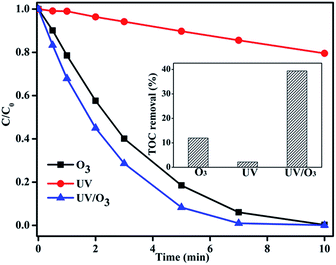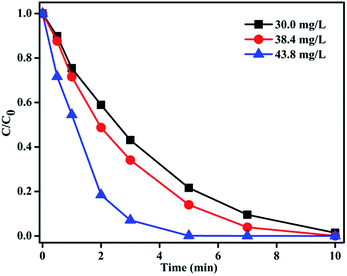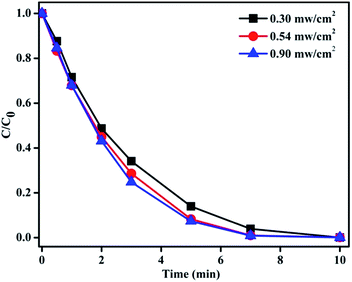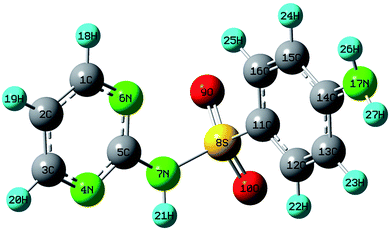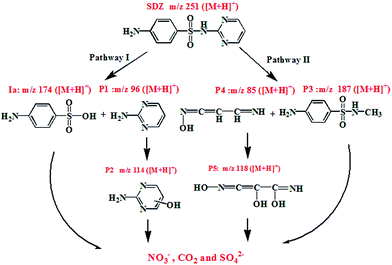Degradation of sulfadiazine in water by a UV/O3 process: performance and degradation pathway†
Wanqian Guo*a,
Zizeng Yanga,
Juanshan Dua,
Renli Yina,
Xianjiao Zhoua,
Shuilin Jinb and
Nanqi Rena
aState Key Laboratory of Urban Water Resource and Environment, Harbin Institute of Technology, Harbin 150090, PR China. E-mail: guowanqian@126.com; Fax: +86-451-86283008; Tel: +86-451-86283008
bDepartment of Math, Harbin Institute of Technology, Harbin 150001, PR China
First published on 26th May 2016
Abstract
In this study, the performance of a combined UV/O3 process for aquatic sulfadiazine (SDZ) removal was investigated. By comparing with UV irradiation or ozonation, the UV/O3 process showed excellent performance for SDZ removal, particularly on the mineralization of SDZ. The degradation rate of SDZ by UV/O3 increased with the increment of O3 gas concentration and UV intensity. Meanwhile, initial solution pH also played an important role in the UV/O3 process. The pH increment of solutions (3.0–9.0) could promote the SDZ degradation rate which was mainly ascribed to the generation of ˙OH by O3 self-decomposition and the dissociation of SDZ. But this phenomenon was seriously reversed for the production of more free radical scavengers like CO32− as initial pH increased from 9.0 to 11.0. Two different degradation pathways of SDZ by UV/O3 were proposed based on the combination of theoretical calculations and experimental intermediate identification. Pathway I was initiated by hydroxyl radicals which involved oxidative cleavage of the S–N bond and pathway II was induced by direct UV irradiation which involved the opening of the pyrimidine ring. According to the results obtained in this work, UV/O3 was recommended as an effective method to remove SDZ.
Introduction
Antibiotics have been widely used in humans and animals for the prevention and treatment of infection and diseases as medicines, and also used as a growth promoter in the livestock industry.1 Most recently, Zhang et al.2 have reported that about 92![[thin space (1/6-em)]](https://www.rsc.org/images/entities/char_2009.gif) 700 tons of 36 typical antibiotics were utilized in China. Besides, the estimated annual dosages of antibiotics for humans and animals have reached 2000 tons in Germany.3
700 tons of 36 typical antibiotics were utilized in China. Besides, the estimated annual dosages of antibiotics for humans and animals have reached 2000 tons in Germany.3
Generally, used antibiotics are excreted as metabolites, conjugates, or in their original parent form and released to the wastewater system.4 Moreover, most antibiotics cannot be removed by conventional wastewater treatment processes and are ultimately discharged into receiving water.5 Thus, more and more researchers have reported that various antibiotics were detected in water matrices at trace levels.6–8 The sulfa drugs or sulfonamides, as the most ancient preventative antibiotics for the treatment of infections in humans and veterinary purposes,9 were repeatedly detected in aquaculture. Even though the detective concentration of sulfonamides in water environment is at the ng L−1 to μg L−1 level, the residual sulfonamides can induce significant changes in the biosphere,1 including acute or chronic toxic effects on organisms, development of antibiotic-resistant bacteria and alteration of aquatic flora.10 Therefore, it is necessary to adopt alternative process to remove sulfonamides from water.
Recent decades, ozonation was proposed to be a suitable process for the removal of various contaminates including antibiotics,11,12 dyes,13 and textile wastewater,14 due to the strong oxidation ability of O3 molecule (E0 = 2.07 V). Garoma et al.15 have reported that O3 can completely remove sulfonamides from aqueous solution. However, low O3 utilization rate and low mineralization in O3 process have been two barriers limiting the application of O3 process. To overcome these disadvantages, various strategies have been used in combination with ozone to enhance the oxidation process, particularly UV radiation. UV/O3 process has shown to be an available option as it has the advantages of oxidizing and destroying organic pollutants in water by combining the beneficial effects of ozonation (direct O3 reactions) with the generation of hydroxyl radicals (˙OH).16,17 The generation of ˙OH involves several chemical processes.18 The decomposition of aqueous O3 in pure water has been firstly initiated by hydroxide ion (eqn (1)) and this reaction leads to the production of radicals that accelerates decomposition process by chains of radical reactions and produce ˙OH (eqn (2)–(4)).19,20 Furthermore, hydrogen peroxide is produced in these processes, thus UV/O3 oxidizing system also involves the behaviour of UV/H2O2 and O3/H2O2. Although UV/O3 has already applied to degrade many refractory containminents,21–23 the performance of combined UV/O3 process on sulfonamides degradation is also obscure and the mechanism or pathway of sulfonamides should be sufficiently confirmed as well.
| O3 + OH− → HO2− + O2 | (1) |
| O3 + H2O2 → HO2− + ˙OH + O2 | (2) |
 | (3) |
 | (4) |
The aim of our study is to investigate the removal efficiency of a typical sulfonamide (sulfadiazine, SDZ) by UV/O3 process under different operational conditions in aqueous solution. In addition, degradation pathways of SDZ in UV/O3 process were also proposed simultaneously based on the theoretical calculation and experimental detection.
Experiment and calculation methods
Materials and reagents
Sulfadiazine (C10H10N4O2S, 99% purity) was purchased from TCI technology CO. Ltd. and used as received without further purification. O3 was generated from pure oxygen gas (99.9%) by an O3 generator (DHX-SS-1G, Harbin Jiu Jiu Electrochemistry Engineering Ltd., Harbin, China). Low-pressure mercury lamps (Haoyan, China) emitting primarily at 254 nm were used as UV-radiation source and placed at the center of the reactor. All organic solvents used for analysis were HPLC grade. Other chemical reagents, such as phosphoric acid and sodium hydroxide were analytical grade (Tianjin chemical Works Co., Tianjin, China). All solutions were prepared using deionized water.Experimental approach
Batch experiments were carried out in a 1.0 L capacity cylindrical glass reactor with the dimensions of 10 cm in diameter, 16 cm height. The reactor was covered by aluminium foil to avoid the release of radiation. The initial pH value was adjusted to 7.0 by phosphoric acid and sodium hydroxide, and not corrected in the experiment. Before the experiment, UV lamp was turned on to warm up at least 20 minutes to make sure stable output. The solution was stirred continuously using a magnetic stirrer. For UV/O3 experiments, appropriate numbers of lamps were inserted into the reactor. At time zero, lamps were turned on and O3 was continuously bubbled into the reactor at the rate of 0.4 L min−1 through a diffuser that was placed at the bottom of the reactor. The off gas was absorbed by potassium iodide solution. The ozone gas concentration could be adjusted by changing the voltage of the machine. Experiments were conducted at room temperature and the increase due to UV irradiation was less than 2 °C. For ozonation experiments, UV lamps were switched off and the experiments were conducted as described as above. For UV experiments, the procedure was the same as UV/O3 process except without O3 gas input. The initial concentration of SDZ was 25 mg L−1 unless other specified. The range of gas O3 concentration was 30.0–43.8 mg L−1 and of UV intensity was 0.30–0.90 mW cm−2. Aliquot samples were withdrawn periodically and analysed for residual concentration of SDZ, intermediates and total organic carbon (TOC). The samples involved in O3 were quenched with 10 μL of sodium thiosulfate (1.0 mol L−1).Analytical methods
The average UV intensity was measured by the method of potassium ferrioxalate actinometry.24 The O3 gas concentration was measured by the potassium iodide method.25 SDZ was analyzed by ultra performance liquid chromatography (UPLC) (Waters ACQUITY UPLC system) equipped with a C18 column (2.1 × 50 mm, 1.7 μm; Waters) interfaced with a TUV detector. The mobile phase was a mixture of acetonitrile (A) and 0.1% formic acid solution (B) and the ratio was 15![[thin space (1/6-em)]](https://www.rsc.org/images/entities/char_2009.gif) :
:![[thin space (1/6-em)]](https://www.rsc.org/images/entities/char_2009.gif) 85. The detection wavelength was set at 265 nm. The injection volume of the sample was 2 μL and the flow rate was 0.1 mL min−1. The degradation intermediate products of SDZ removal by UV/O3 were separated by the Waters ACQUITY UPLC but interfaced with a tandem quadrupole mass detector (Xevo TQD) (Waters ACQUITY UPLC-MS-MS, Milford MA, United States). Mass spectral analysis was conducted in positive mode electrospray ionization ((+)ESI) over a mass range of 50–500 m/z. The cone voltage used was 30 V conducted in auto full scan mode (MS2). Details of the UPLC method description were in accord with the conditions of SDZ quantification mentioned above.
85. The detection wavelength was set at 265 nm. The injection volume of the sample was 2 μL and the flow rate was 0.1 mL min−1. The degradation intermediate products of SDZ removal by UV/O3 were separated by the Waters ACQUITY UPLC but interfaced with a tandem quadrupole mass detector (Xevo TQD) (Waters ACQUITY UPLC-MS-MS, Milford MA, United States). Mass spectral analysis was conducted in positive mode electrospray ionization ((+)ESI) over a mass range of 50–500 m/z. The cone voltage used was 30 V conducted in auto full scan mode (MS2). Details of the UPLC method description were in accord with the conditions of SDZ quantification mentioned above.
Computational details
Molecular calculations were performed to facilitate the understanding of SDZ degradation mechanisms by UV/O3 process. The reaction model used in the computational part of this study was the reaction between the SDZ molecule and the ˙OH radical. Hartree–Fock (HF) methods suffer from spin contamination and it is not suitable for the reaction system involved in the ˙OH radical. In contrast to the HF methods, density functional theory (DFT) methods used the exact electron density instead of the wave function to calculate molecular properties and energies. They suffer from spin contamination less than HF methods and this feature makes them suitable for calculations involved ˙OH radical system. Therefore, geometry optimizations of the reactants were performed with the DFT method.26 The DFT calculations were carried out as implemented in Gaussian 09 code,27 using the exchange–correlation functional B3LYP in combination with the 6-31 (g, p) basis set. The IEFPCM model was adopted to evaluate solvent effect of water. Vibrational frequencies were calculated for the determination of the structures as stationary points and true minima on the potential energy surfaces.Results and discussion
Degradation of SDZ by UV/O3
As shown in Fig. 1, comparative experiments in pure water were conducted to investigate the degradation efficiency and mineralization of SDZ by O3 alone, UV alone, and UV/O3 processes where the O3 gas concentration was 38.4 mg L−1, average UV intensity was 0.3 mW cm−2, and the initial pH value was 7.0. Direct UV could only remove 20% SDZ after 10 min irradiation and little TOC removal rate after 30 min irradiation, and the result was consistent with previous study.28 Compared with UV process, O3 and UV/O3 processes showed much higher SDZ removal rate. O3 has strong oxidation ability and it could easily react with SDZ.15 In the UV/O3 process, it is believed that UV irradiation could increase the O3 usage rate and generate more ˙OH which enhanced the degradation of SDZ.29,30Although SDZ could be eliminated by O3 within a short time, TOC removal rate of SDZ degradative process was only 12% after 30 min ozonation indicating that SDZ could not be completely mineralized by O3 and many degradation intermediates might accumulate in the system. However, for the mineralization of SDZ, O3 and UV/O3 make great differences as shown in the inset of Fig. 1. It was found that UV/O3 process exhibited a better performance in TOC removal rate than individual O3 process after 30 min treatment. The advantages of UV/O3 in mineralization of SDZ were mainly ascribed to multiple chemical reactions involved as previously described and the generation of ˙OH which owned a high oxidation potential and was less discriminating in the types of attacking functional groups.31,32 Thus, the UV/O3 process is a feasible way to eliminate and mineralize SDZ and intermediates from water and it would be meaningful to clarify the factors which significantly influence the performance of UV/O3 process.
Key factors affecting SDZ degradation in the UV/O3 system
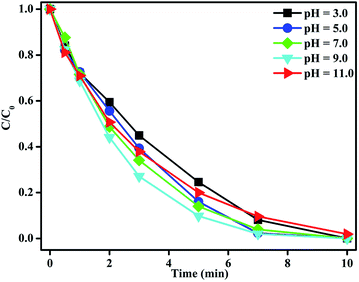 | ||
| Fig. 4 Removal of SDZ by UV/O3 process at different pH values. Experimental conditions: O3 concentration was 38.4 mg L−1; UV intensity = 0.30 mW cm−2, initial SDZ concentration = 25 mg L−1. | ||
Besides, pH of the solution also decided existing form of SDZ considering the chemical nature of the SDZ molecule. SDZ is characterized by having two acid equilibrium constant values (pKa1 = 2.49 and pKa2 = 6.48) for the presence of amidogen and hydroxyl. Hence, deprotonated amidogen as nucleophilic group gradually dominated over the pH range of 3.0 to 11.0; moreover, dissociated hydroxyl as electrophilic group could be dominated as pH increased to 6.48. It is known that deprotonated amidogen and dissociated hydroxyl which both possessed more electron could be more easily attacked by ˙OH and molecular O3. Thus, the acid–base species transformation of SDZ also explained the increment of SDZ degradation rate with the increasing of pH in the UV/O3 system. In addition, SDZ degradation rate was slightly promoted with the increase of pH ranged from 7.0 to 9.0, but neutral solution was much convenient for direct disposal of wastewater. So, pH 7.0 was considered as the most appropriate value for SDZ oxidation by UV/O3.
Analysis of degradation pathway of SDZ by UV/O3 process
| Atoms | Ci | Atoms | Ci | Atoms | Ci | Atoms | Ci |
|---|---|---|---|---|---|---|---|
| 1C | 0.07 | 8S | 2.364 | 15C | −0.291 | 22H | 0.268 |
| 2C | −0.343 | 9O | −0.958 | 16C | −0.191 | 23H | 0.256 |
| 3C | 0.068 | 10O | −0.978 | 17N | −0.828 | 24H | 0.255 |
| 4N | −0.525 | 11C | −0.407 | 18H | 0.245 | 25H | 0.273 |
| 5C | 0.592 | 12C | −0.199 | 19H | 0.267 | 26H | 0.428 |
| 6N | −0.531 | 13C | −0.289 | 20H | 0.245 | 27H | 0.428 |
| 7N | −0.892 | 14C | 0.203 | 21H | 0.469 |
Identification of intermediates and possible reaction pathway
To elucidate the degradation pathways of SDZ oxidation by UV/O3, the reaction intermediates were detected by UPLC-MS/MS. Six compounds ([M + H]+) were identified with peaks of m/z 251, m/z 187, m/z 118, m/z 114, m/z 96 and m/z 85. The peak of m/z 251 represented parent SDZ. Product 1 (P1) was identified as 2-pyrimidinamine with m/z 96 and product 2 (P2) was identified as hydroxylated 2-pyrimidinamine. Besides, product 3 (P3) was identified as 4-amino-N-methylbenzenosulfonamide with m/z 187 and product 4 (P4) was identified as 3-imino-propen-1-one oxime with m/z 85. Product 5 (P5) was identified 2-hydroxy-3-hydroxyimino-acrylimidic acid with m/z 118.According to analytical intermediates above, degradation pathways of SDZ oxidation by UV/O3 are illustrated in Fig. 6. The degradation of SDZ by UV/O3 involved two possible pathways (I and II). In pathway I, as predicted by molecular calculations, the generation of P1 and Ia (m/z 174) were ascribed to the cleavage of S–N bond by ˙OH attack. This process could also be found in SDZ removal by other oxidation systems such as, gamma irradiation process and Fenton process.38,39 Then ˙OH added to pyrimidine ring of P1 resulting in the formation of P2. In pathway II, the first step for the degradation of SDZ in the UV/O3 system involved the open of pyrimidine ring generating P3 and P4. Then ˙OH took place of hydrogen atoms of P4 to form P5. However, according to the calculation results, pyrimidine ring was not the prior target which ˙OH radicals could attack.
In order to figure out the mechanism, the reaction intermediates of SDZ oxidation by individual UV radiation and O3 were detected. The peak of m/z 187 was not detected in O3 process, meanwhile, only two intermediates with peak of m/z 187 and m/z 114 were found in individual UV radiation. Thus, we concluded that the pathway II might be initiated by direct UV radiation not by ˙OH. Moreover, SDZ oxidation by UV/O3 producing more abundant intermediates than by alone UV or O3 indicated that the UV/O3 system possessed advantages in mineralization of contaminants.
It should be mentioned that although Ia had only been deduced as possible intermediate of the SDZ degradation (not directly detected), the proposed mechanism can be substantiated by considering that they were quickly eliminated by the ˙OH, thereby preventing accumulation in the system.
Conclusions
SDZ removal using combined UV/O3 process was investigated and its possible degradation pathway was induced based on both theoretical calculation and experimental detection. Results showed that the UV/O3 process was an effective method to degrade SDZ from water. In addition, it performed better considering the degradation efficiency and mineralization compared with UV and O3 alone processes under same conditions. Effects of O3 gas concentration, UV intensity, and initial solution pH value on SDZ removal by the UV/O3 process were investigated. Solution pH played an important role in UV/O3 process as it not only affected the decomposition of aqueous O3 and the ˙OH production, but also decided the existing forms of SDZ in solution.Natural population analysis was used to predict the possible degradation pathway of SDZ in the UV/O3 process. And calculation results showed that 7(N), 9(O), 10(O) and 17(N) had relatively bigger negative values and the connected bonds of these atoms were easily broken under UV/O3 process. By combining the analytical results of detected intermediates by UPLC-MS, two degradation pathways were deduced. In pathway I, degradation of SDZ was initiated by the broken of S–N bond under the attack of ˙OH radical. And, pathway II might be initiated by the direct UV radiation based on similar intermediates detected in UV alone irradiation but not in ozonation processes. The UV/O3 system could produce more easy-to-degrade intermediates than UV or ozonation alone in SDZ degradation which implied that the UV/O3 system be more suitable for the mineralization of such organic pollutants.
Acknowledgements
This work was financially supported by National science and technology plan of China (2014BAD02B03), and Fund for young top-notch talent teachers by Harbin Institute of Technology (AUGA5710052514). The authors also gratefully acknowledge the financial support by State Key Laboratory of Urban Water Resource and Environment (ES201602).References
- K. Kummerer, Chemosphere, 2009, 75, 417–434 CrossRef PubMed.
- Q. Q. Zhang, G. G. Ying, C. G. Pan, Y. S. Liu and J. L. Zhao, Environ. Sci. Technol., 2015, 49, 6772–6782 CrossRef CAS PubMed.
- E. Meyer, P. Gastmeier, M. Deja and F. Schwab, Int. J. Med. Microbiol., 2013, 303, 388–395 CrossRef PubMed.
- X. Liu, T. Garoma, Z. Chen, L. Wang and Y. Wu, Chemosphere, 2012, 87, 1134–1140 CrossRef CAS PubMed.
- W. Xu, G. Zhang, X. Li, S. Zou, P. Li, Z. Hu and J. Li, Water Res., 2007, 41, 4526–4534 CrossRef CAS PubMed.
- M. J. García-Galán, T. Garrido, J. Fraile, A. Ginebreda, M. S. Díaz-Cruz and D. Barceló, J. Hydrol., 2010, 383, 93–101 CrossRef.
- K. He, A. D. Soares, H. Adejumo, M. McDiarmid, K. Squibb and L. Blaney, J. Pharm. Biomed. Anal., 2015, 106, 136–143 CrossRef CAS PubMed.
- L. J. Zhou, G. G. Ying, S. Liu, J. L. Zhao, B. Yang, Z. F. Chen and H. J. Lai, Sci. Total Environ., 2013, 452–453, 365–376 CrossRef CAS PubMed.
- A. L. Boreen, W. A. Arnold and K. McNeill, Environ. Sci. Technol., 2004, 38, 3933–3940 CrossRef CAS PubMed.
- J.-F. Yang, G.-G. Ying, J.-L. Zhao, R. Tao, H.-C. Su and F. Chen, Sci. Total Environ., 2010, 408, 3424–3432 CrossRef CAS PubMed.
- W. Guo, Q.-L. Wu, X.-J. Zhou, H.-O. Cao, J.-S. Du, R.-L. Yin and N.-Q. Ren, RSC Adv., 2015, 5, 52695–52702 RSC.
- W. Q. Guo, R. L. Yin, X. J. Zhou, J. S. Du, H. O. Cao, S. S. Yang and N. Q. Ren, Ultrason. Sonochem., 2015, 22, 182–187 CrossRef CAS PubMed.
- X. J. Zhou, W. Q. Guo, S. S. Yang, H. S. Zheng and N. Q. Ren, Bioresour. Technol., 2013, 128, 827–830 CrossRef CAS PubMed.
- C. A. Somensi, E. L. Simionatto, S. L. Bertoli, A. Wisniewski Jr and C. M. Radetski, J. Hazard. Mater., 2010, 175, 235–240 CrossRef CAS PubMed.
- T. Garoma, S. K. Umamaheshwar and A. Mumper, Chemosphere, 2010, 79, 814–820 CrossRef CAS PubMed.
- T. Garoma, M. D. Gurol, L. Thotakura and O. Osibodu, Chemosphere, 2008, 73, 1708–1715 CrossRef CAS PubMed.
- T. E. Agustina, H. M. Ang and V. K. Vareek, J. Photochem. Photobiol., A, 2005, 6, 264–273 CrossRef CAS.
- T. Garoma and M. D. Gurol, Environ. Sci. Technol., 2004, 38, 5246–5252 CrossRef CAS PubMed.
- J. Staehelin and J. Hoigne, Environ. Sci. Technol., 1982, 16, 676–681 CrossRef CAS.
- R. E. Buehler, J. Staehelin and J. Hoigne, J. Phys. Chem., 1984, 88, 2560–2564 CrossRef CAS.
- J. Chang, Z.-l. Chen, Z. Wang, J. Kang, Q. Chen, L. Yuan and J.-m. Shen, Chem. Eng. J., 2015, 276, 97–105 CrossRef CAS.
- F. J. Beltran, A. Aguinaco, J. F. Garcia-Araya and A. Oropesa, Water Res., 2008, 42, 3799–3808 CrossRef CAS PubMed.
- B. Cuiping, X. Xianfeng, G. Wenqi, F. Dexin, X. Mo, G. Zhongxue and X. Nian, Desalination, 2011, 278, 84–90 CrossRef.
- G. Harris, V. Dean Adams, W. Moore and D. Sorensen, J. Environ. Eng., 1987, 113, 612–627 CrossRef CAS.
- K. Rakness, G. Gordon, B. Langlais, W. Masschelein, N. Matsumoto, Y. Richard, C. M. Robson and I. Somiya, Ozone: Sci. Eng., 1996, 18, 209–229 CrossRef CAS.
- Y. Y. Gurkan, N. Turkten, A. Hatipoglu and Z. Cinar, Chem. Eng. J., 2012, 184, 113–124 CrossRef CAS.
- M. J. Frisch, G. W. Trucks, H. B. Schlegel, G. E. Scuseria, M. A. Robb, J. R. Cheeseman, G. Scalmani, V. Barone, B. Mennucci, G. A. Petersson, H. Nakatsuji, M. Caricato, X. Li, H. P. Hratchian, A. F. Izmaylov, J. Bloino, G. Zheng, J. L. Sonnenberg, M. Hada, M. Ehara, K. Toyota, R. Fukuda, J. Hasegawa, M. Ishida, T. Nakajima, Y. Honda, O. Kitao, H. Nakai, T. Vreven, J. A. Montgomery Jr, J. E. Peralta, F. Ogliaro, M. Bearpark, J. J. Heyd, E. Brothers, K. N. Kudin, V. N. Staroverov, T. Keith, R. Kobayashi, J. Normand, K. Raghavachari, A. Rendell, J. C. Burant, S. S. Iyengar, J. Tomasi, M. Cossi, N. Rega, J. M. Millam, M. Klene, J. E. Knox, J. B. Cross, V. Bakken, C. Adamo, J. Jaramillo, R. Gomperts, R. E. Stratmann, O. Yazyev, A. J. Austin, R. Cammi, C. Pomelli, J. W. Ochterski, R. L. Martin, K. Morokuma, V. G. Zakrzewski, G. A. Voth, P. Salvador, J. J. Dannenberg, S. Dapprich, A. D. Daniels, O. Farkas, J. B. Foresman, J. V. Ortiz, J. Cioslowski and D. J. Fox, Gaussian Inc., Wallingford CT, 2013.
- N. Lemańska-Malinowska, E. Felis and J. Surmacz-Górska, Arch. Environ. Prot., 2013, 39, 79–91 Search PubMed.
- B. S. Oh, Y. J. Jung, Y. J. Oh, Y. S. Yoo and J. W. Kang, Sci. Total Environ., 2006, 367, 681–693 CrossRef CAS PubMed.
- V. V. Goncharuk, V. F. Vakulenko, Y. O. Shvadchina, A. N. Sova and T. N. Sitnichenko, J. Water. Chem. Tech., 2009, 31, 81–91 CrossRef.
- H. Kusic, N. Koprivanac and A. L. Bozic, Chem. Eng. J., 2006, 123, 127–137 CrossRef CAS.
- O. Legrini, E. Oliveros and A. M. Braun, Chem. Rev., 1993, 93, 671–698 CrossRef CAS.
- Y. Ku, W. Wang and Y.-S. Shen, J. Hazard. Mater., 2000, 72, 25–37 CrossRef CAS PubMed.
- W. Chu and C.-W. Ma, Water Res., 2000, 34, 3153–3160 CrossRef CAS.
- M. Mehrjouei, S. Müller and D. Möller, Chem. Eng. J., 2015, 263, 209–219 CrossRef CAS.
- S. Song, Z. Liu, Z. He, Y. Li, J. Chen and C. Li, Chemosphere, 2009, 77, 1043–1051 CrossRef CAS PubMed.
- I. A. Alaton, I. A. Balcioglu and D. W. Bahnemann, Water Res., 2002, 36, 1143–1154 CrossRef CAS PubMed.
- Z. Guo, F. Zhou, Y. Zhao, C. Zhang, F. Liu, C. Bao and M. Lin, Chem. Eng. J., 2012, 191, 256–262 CrossRef CAS.
- J. F. Yang, S. B. Zhou, A. G. Xiao, W. J. Li and G. G. Ying, J. Environ. Sci. Health, Part B, 2014, 49, 909–916 CrossRef CAS PubMed.
Footnote |
| † Electronic supplementary information (ESI) available. See DOI: 10.1039/c6ra09078h |
| This journal is © The Royal Society of Chemistry 2016 |

